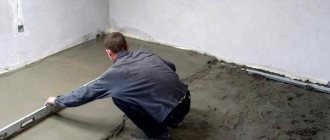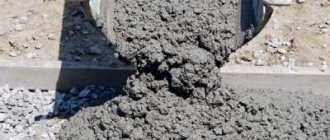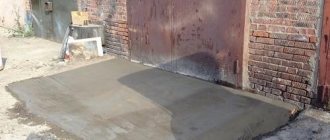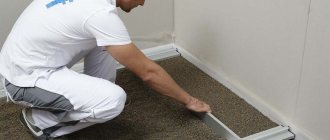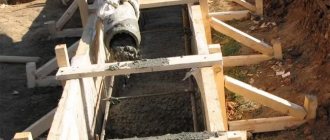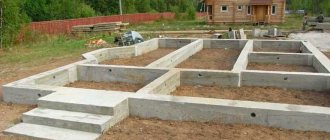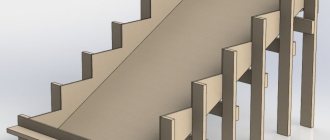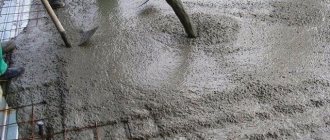Reinforcement of underlying layers and concrete layers
FEDERAL UNIT PRICE FER 06-01-015-10
| Name | Unit |
| Reinforcement of underlying layers and concrete layers | 1 t |
| Scope of work | |
| 01. Installation of fittings | |
The price takes into account only the direct costs of work for the period 2000
(Federal prices), which are calculated according to the GESN standards of the
2009
. For further application, the conversion factor to the current prices is applied to the specified price.
You can go to the pricing page, which is calculated based on the 2014 edition standards with additions 1
| Total (RUB) | Workers' compensation | Machine operation | Pay for drivers | Cost of materials | Labor costs (person-hours) |
| 6084,69 | 111,99 | 37,1 | 2,16 | 5935,6 | 12,64 |
TOTAL PRICE: 6,084.69 RUR.
Look at the resource part of the price in the GESN standard 06-01-015-10
When used in an estimate, the price requires indexation to translate into current prices. The price is based on the GESN-2001 standards, as amended in 2009.
in
2000
.
Source
Reinforcement of underlying layers and concrete layers
FEDERAL UNIT PRICE FER 06-03-004-12
| Name | Unit |
| Reinforcement of underlying layers and concrete layers | T |
| Scope of work | |
| 01. Installation of fittings. | |
| Total (RUB) | Workers' compensation | Machine operation | Pay for drivers | Cost of materials | Labor costs (person-hours) |
| 418,83 | 102,78 | 30,45 | 4,35 | 285,6 | 11,6 |
| Cipher | Name | Unit Change | Consumption | Price Unit | Total |
| 08.4.03.03 | Reinforcing steel for monolithic reinforced concrete structures | T | 1 | 0,00 | 0,00 |
TOTAL PRICE: 418.83 RUR.
Look at the resource part of the price in the GESN standard 06-03-004-12
Source
Reinforcement of cement concrete pavements: meshes
FEDERAL UNIT PRICE FER 31-01-061-01
| Name | Unit |
| Reinforcement of cement concrete pavements: meshes | 1 t |
| Scope of work | |
| 01. Installation of reinforcing mesh or frames. 02. Bundle of joints of meshes or frames. | |
The price takes into account the work requirements for 2000
(Moscow prices), calculated according to the GESN model of 2009
. Indexation of translation into current prices must be applied to the cost.
You can go to the pricing page, which is calculated based on the 2014 edition standards with additions 1
| Total (RUB) | Workers' compensation | Machine operation | Pay for drivers | Cost of materials | Labor costs (person-hours) |
| 7323,12 | 36,97 | 81,92 | 6,08 | 7204,23 | 3,98 |
TOTAL PRICE: RUB 7,323.12.
Look at the cost of this standard at current prices open page
Look at the resource part of the price in the GESN standard 31-01-061-01
When used in an estimate, the price requires indexation to translate into current prices. The price is based on the GESN-2001 standards, as amended in 2009.
Other types of mesh
The meshes differ in the material they are made of. Of course, steel products are considered the traditional recognized leader for brickwork. But there are other options that are quite appropriate for brick walls.
TsPVS
Expanded metal mesh (CPVS) or simply “expanded mesh” is considered stronger than the usual steel version. Made from sheet metal produced using the cold rolling method. A distinctive feature is that the grid cells are diamond-shaped.
The material has a number of advantages:
- easy to cut and cut;
- It is lightweight, making it easier to work with;
- costs less than similar reinforcing mesh;
- can be used for thin masonry;
- Fixation in masonry with adhesives is possible.
Available in rolls, has a protective anti-corrosion coating, and can be easily cut to the required size. For the construction of a small private house made of brick, TsPVS is considered the best option.
Basalt mesh
In recent years, basalt masonry mesh has become the most popular in the reinforcement of brickwork, which is explained by its many advantages:
- provides flexible connections between walls and cladding;
- easy to cut with ordinary metal scissors;
- resistant to most aggressive environments;
- has dielectric properties;
- combines, except brick, with almost all wall materials;
- has low thermal conductivity.
An important practical advantage: the cost of a basalt analogue is approximately three times less than metal products
Making a screed with reinforcing mesh
Preparing the floor for screed
Using a construction laser level, the highest point of the rough foundation is calculated. For ease of installation of the screed, markings are also applied to the walls of the room, indicating the boundary of the screed pouring.
Using a Laser Level
Attention! At the highest point of the base, the screed layer should be at least 4 cm.
After preparation, installation of the screed begins.
The mesh must be laid on pieces of brick
Attention! The mesh should not lie on the base. In order for it to fulfill its functions of strengthening the screed, it is raised above the surface. As a result, upon completion of the work, the mesh will be located exactly inside the screed.
Step 2. The reinforcing mesh is laid on the installed pieces of brick so that its individual pieces are overlapped by at least 1-2 cells.
Overlap between pieces of reinforcing mesh
Step 3. Beacons are installed. These are guide pieces of reinforcement or metal profile. They are installed parallel to one of the walls of the room. The level of beacons is controlled using a long board.
Step 4. The cement mixture is prepared for pouring the screed. It is then fed directly onto the surface covered with a mesh.
Kawabanga! Gravity concrete mixer
How to properly prepare a screed solution
Pouring cement mixture
Advice! A layer of damper tape is laid along the walls. This is necessary to compensate for the thermal expansion of the screed.
Step 5. The cement mixture is distributed evenly over the surface.
Distribution of the mixture over the surface
Step 6. Using the rule, the screed is made smooth and neat. The rule is to slide along the beacons during operation.
Aligning the screed with the rule
Advice! A perfectly flat floor can be obtained by filling the rough screed with a self-leveling compound.
Video - Laying the mesh
Video - Rough screed
Reinforcing elements: what strengthens the screed?
The following materials can be used to reinforce screeds:
Polymer and fiberglass meshes have a weaker tensile strength than metal meshes, so they are used for screeds subject to light loads. As a rule, these are floors in apartments and private houses.
Let's look at each type of reinforcing elements in more detail.
Option #1 - metal mesh
Special metal mesh for reinforcement is made from VR-1 steel wire connected by spot welding. The diameter of the wire used is 2.5-6 mm.
The main advantages of metal mesh for reinforcement:
To lay a screed reinforced with metal mesh, do the following:
Kawabanga! Crushers for concrete and reinforced concrete: what is it, the use of a shredder, types of equipment
Thus, the reinforcement procedure does not significantly complicate the screed creation technology. At the same time, it significantly increases its performance characteristics.
Option #2 - plastic mesh
When reinforcing unloaded screeds up to 80 mm thick, the metal mesh can be replaced with a polymer analogue - a mesh made of polypropylene (plastic).
Plastic mesh is not subject to corrosion and is not affected by aggressive environments. The appearance of rust in the cement mortar and, as a consequence, the appearance of red spots on the surface of the screed are excluded.
Advantages of polymer mesh as a material for screed reinforcement:
Reinforcement of the screed using plastic mesh is carried out according to the same scheme as with metal mesh.
Option #3 - fiberglass mesh
Another option for screed reinforcement involves the use of fiberglass mesh. These are meshes with square cells (usually 4-6 mm), made of aluminoborosilicate glass by openwork weaving.
Fiberglass is very light and does not create unnecessary loads on the floor. Due to its light weight and the ability to roll into rolls, the material is easy to transport even by non-truck transport or carried manually.
In a screed, fiberglass performs the same functions as plastic mesh. That is, it prevents the occurrence of shrinkage cracks and local destruction, and increases the strength of the screed.
Advantages of fiberglass mesh:
- light weight;
- high tensile strength;
- resistance to temperature changes;
- resistance to aquatic environments;
- chemical neutrality (in case of using alkali-resistant impregnations);
- easy installation.
Installation of fiberglass mesh is carried out in the same way as when using other types of mesh.
Reinforcement of underlying layers and concrete layers
FEDERAL UNIT PRICE FER 06-01-015-10
| Name | Unit |
| Reinforcement of underlying layers and concrete layers | 1 t |
| Scope of work | |
| 01. Installation of fittings | |
The price takes into account only the direct costs of work for the period 2000
(Federal prices), which are calculated according to the GESN standards of the 2009
. For further application, the conversion factor to the current prices is applied to the specified price.
You can go to the pricing page, which is calculated based on the 2014 edition standards with additions 1
| Total (RUB) | Workers' compensation | Machine operation | Pay for drivers | Cost of materials | Labor costs (person-hours) |
| 6084,69 | 111,99 | 37,1 | 2,16 | 5935,6 | 12,64 |
TOTAL PRICE: 6,084.69 RUR.
Look at the cost of this standard at current prices open page
Look at the resource part of the price in the GESN standard 06-01-015-10
When used in an estimate, the price requires indexation to translate into current prices. The price is based on the GESN-2001 standards, as amended in 2009.
Zero level mark
We received a shallow pit and marked it with a cord, which will allow us to evenly lay the cushion of sand and crushed stone. Before filling the pillow, you need to set the thickness to which the materials will be poured under the base of the screed. For this purpose, the zero floor level is determined. Often the floor screed is aligned with the gate threshold, this facilitates convenient entry of the car.
It is necessary to determine the thickness of the future concrete base and not occupy it before pouring. If you have chosen a screed with a thickness of 10 cm, then 10 cm is counted down from the gate threshold using a tape measure. After determination, the zero level is marked along the entire perimeter of the walls. To do this, builders use a laser level. It makes it easy and simple to mark the distance, but this process can also be done using a regular building level.
Requirements for the screed device
Thus, the minimum layer thickness when laying on a concrete base is 20 mm. If an additional insulating layer or soundproofing materials are laid, the thickness will be 40 mm. If a pipeline or other communications are installed in the screed, then the layer above the communications should be no less than 20 mm.
https://www.youtube.com/watch?v=ytaboutru
If compressible materials are used as heat or sound insulation, then the strength of the sand and cement fill is increased. It should be no less than 2.5 MPa. In this case, the thickness of the screed should prevent any deformation.
To control the plane of the coating, the regulations provide for the use of a rule. If it is necessary to check the geometric characteristics of the layer, use a tool 2 m long.
We suggest you familiarize yourself with Which side to lay the hydro-vapor barrier on the floor
According to SNiP, it is allowed if the floor screed has deviations, but not more than the specified values:
- For parquet, laminate, linoleum and self-leveling floors on polymer mixtures, 2 mm by 2 m is allowed;
- For other types of coatings, up to 4 mm per 2 m is allowed.
When monitoring the surface, deviations from these standards are leveled out first, since they have a great influence on how well the finishing floor covering will be laid.
Thus, the foundation should be planned according to the profile or marks in the design documents. If it is necessary to add soil, the layer is compacted and leveled as much as possible. A mixture of sand and gravel is often used as backfill.
If floors are laid on the ground, then work can only be done when it thaws. If the soil surface is weak enough, replacement or additional strengthening is required. It is recommended to strengthen with crushed stone with a fraction of 40-60 mm. In this case, the strength must be no less than 200 kgf/m2.
If the base is a concrete slab, then it is cleared of debris and dust. Then the surface is washed with water. If there are joints between the slabs, they are filled with cement-sand mortar. In this case, the filling depth must be no less than 50%. For these purposes, a solution of grades 150 or more is used.
The base base is processed according to all the previously described recommendations. Then it is necessary to treat the surface with primers. After the primer composition has sufficiently polymerized, a cement mortar is prepared in a ratio of 1:3, where 1 part is cement and 3 parts sand.
If sound or heat insulating materials are used, then a damper tape with a thickness of 10 to 25 mm is installed around the perimeter of the room. Also, beacon slats are installed on the floor, and then the screed is poured.
The floor will be ready no earlier than in 24 hours. You should not walk on the base with your feet. If there is a lot of time, it is better to give the screed 30 days. You can then begin sanding and applying the topcoat.
Grand estimate for floor screed reinforcement
Sorted by relevance
| Sort by date
Author: Sergey. Good day! Tell me what price to take to calculate: The workers laid reinforced
mesh
for the screed, and then manually poured concrete on the floor in the grain warehouse?
Author: Alexey. Good afternoon! help with the blind area. There is a new price for repairs according to collection 69. but I'm using guides and grid
for reinforcement
. how to draw up a document correctly
How to calculate the reinforcement of a cement screed in tons
| Quote |
| Elena Anikina wrote: reinforcement in tons, how to calculate the thickness of the screed? |
There is no direct relationship between the weight of the mesh and the thickness of the screed; the thickness of the reinforcement (wire) and compliance with the thickness of the protective layer play a role here. There is a good article “Rules for the reinforcement of floor screeds”, which shows in simple words the types of screeds, when and what kind of reinforcement is used
When calculating the mass of reinforcement (as in the previous message), do not forget to take into account 3-5% for mesh overlap
| Quote |
| Voloshin Dmitry wrote: Hello! Tell me how to take into account in the estimate the costs of installing damper tape when installing screeds indoors? The material is not normally available, but what about the work? I did not see this operation in the norms of table 11-01-011. Maybe I misunderstood something? |
The screed installation work does not include installation of a damper tape. Some customers do not want to skip the work of installing the tape, allowing it to be added only as a material. But any work must be paid for, and if the volumes are large, then this means other money. The damper tape for the screed is laid along the perimeter of the room. Before carrying out work, it is necessary to clean the room from dirt and dust in order to securely fix the damper tape
I agree with the opinion above that the installation of the tape can be taken from the collection FER46-08-022-05 “Waterproofing with swelling self-adhesive tape: horizontal seams”, in the scope of work we need: 1. Unloading materials at the work site. 2. Cleaning the concrete surface with compressed air using a compressor. 3. Laying waterproofing self-adhesive tape, including joining.
With the replacement of the material “Waterproofing tape” with damper tape.
Source
Advantages of concreting
You can fill your garage floor with your own hands easily and efficiently. Do-it-yourself work will be cheaper, since hired workers and special equipment are not required. The concrete type of pouring has been proven over the years, it is very reliable and is often used in construction of any complexity.
Concrete screed in the garage has the following advantages:
The comfort of being in the garage largely depends on whether the floor is made correctly
Concrete floors can be painted or tiled. This finishing coating will reduce the formation of dust under the wheels of the car, because it settles throughout the garage and brings discomfort to the owner.
Reinforcement of structures
This work is done quite simply, because the instructions for installing a metal frame are approximately the same for all products.
The only thing is that before you start reviewing technologies, you should familiarize yourself with where exactly it is relevant to use the assembly of a frame made of steel rods.
What must be reinforced: Products that do not always need to be reinforced: · Flights of stairs.
· Brickwork of permanent buildings.
· Concrete floors that are more than 10 cm thick and are built on loose soil.
· Monolithic walls and ceilings. · Cement-sand screeds. Especially those that are located on concrete slabs and other solid foundations.
· Masonry of small structures. This, for example, could be sheds, outdoor toilets, etc.
Installation of concrete floors thickness: 100 mm
FEDERAL UNIT PRICE FER 11-01-014-01
| Name | Unit |
| Installation of concrete floors thickness: 100 mm | 100 m2 floor |
| Scope of work | |
| 01. Wetting the base with water. 02. Installation of lighthouse slats. 03. Receiving and laying ready-mixed concrete with leveling. 04. Compacting concrete and leveling the surface. 05. Laying filter cloths and suction mat. 06. Vacuuming. 07. Removing, cleaning and washing the filter cloths and suction mat. 08. Removing, cleaning the lighthouse slats and sealing the remaining grooves. 09. Smoothing and grouting the coating surface. | |
Concrete floor in the garage - the difference between brands of cement
Work on creating a garage floor begins with the selection of building materials. Among them, the most important is cement - the main component for creating concrete. And here it is necessary to make a small theoretical digression, which will prevent subsequent confusion and reduce the risk of error when choosing building materials. Let's consider what types of concrete/cement there are, and whether there is a direct connection between them.
Most often, in the construction of foundations, walls, floors and other concrete structures, Portland cement is used - cement with a predominant content of calcium silicate
The characteristics and composition of building materials used both for the construction of industrial structures and public buildings, and for private houses and outbuildings, are quite accurately defined in state standards. In particular, this applies to concrete. Its main characteristic is compressive strength, measured in kilogram-force per square centimeter (or abbreviated kgf/cm2). It is this that is indicated in the marking of concrete behind the letter M. You can see the main subtypes of concrete, differing in compressive strength and areas of application, below.
Table. Concrete – main grades.
Why is reinforcement needed?
Everything is actually very simple - if inside the concrete layer there is a frame made of reinforcement, then such a structure will be of better quality in every sense.
Specific properties with and without reinforcement are given below in the comparison table.
Properties of the product with reinforcement: Properties of the product without reinforcement: High compressive and tensile strength. Without reinforcement, compressive and tensile strength is available only for products that have a small area, length and width. Long service life. Here the service life, as a rule, is not as long as with the presence of rods. Ability to withstand very significant mechanical shocks. In principle, the product will withstand some blows, of course, but definitely not strong ones.
It turns out that a concrete product, the structure of which has a metal frame, in theory, lasts longer and has an excellent margin of safety.
Please note that reinforcement laid into concrete with your own hands may still introduce one drawback to such a product. The fact is that due to the presence of a large amount of metal, the overall weight of the structure increases significantly. And this is not always acceptable.
Table calculating the weight of reinforcement depending on its diameter
So, we’ve sorted this out, now let’s look at how various structures are made using reinforcement.
Reinforcement of floor screed, price in estimate
Good afternoon, dear readers! Floor screed during renovation work allows you to level the surface and also create a basis for further installation of flooring. However, despite the large number of methods for laying floors, experts recommend additional reinforcement of the floor covering. Consumers agree to this with difficulty because they do not have a clear understanding of this process. The article will discuss in detail the reinforcement of floor screeds and the cost in the estimate.
Features of the technology
Reinforcement is a method of increasing the load-bearing capacity of a structure. Particles of more durable raw materials than the main building material are introduced into the surface. Most often, concrete is reinforced, which collapses when dried out, under heavy loads or due to sudden changes in temperature (humidity).
Reinforced screed differs from conventional screed by the presence of additional reinforcing parts inside. The reinforcing structure is ideal for rooms with uneven floors. Using the technology, it is possible to quickly and easily distribute the solution over the surface, and the inclusions will withstand the mass of building material without deformation.
The floor is reinforced with a screed to prevent subsidence under the elastic base. Reinforcement is not necessary for hard surfaces or thin (up to 6 cm) screed. Technology is required for:
- insulation of any type;
- soil prone to swelling (sand, gravel);
- hydro-heat and sound insulation;
- rough floor along joists.
Additional elements take on the compressive effect, protecting the concrete from natural shrinkage. If a floating or composite structure is made on the floor, then reinforcement must be used. The inclusions neutralize bending loads.
Why do you need to reinforce the floor? Source oboiman.ru
A reinforced floor screed is needed when the fill thickness is 10 cm or more. Surface reinforcement is used when installing electric “warm floors”, preventing problems due to temperature and humidity changes. When heating with water, pipes are additionally tied to the reinforcing structure.
Prices for work
The work can be carried out in different ways depending on the operations that need to be carried out on the original coating.
The following are prices for basic types of such work:
In addition, as advice, experts recommend strictly following the technological processes in this matter, as well as using concrete mixers to create the mixture. It is better not to save on the cost of materials. Of course, in fact this is not the cheapest operating technology, but the quality of the floor covering will cover such costs.
This concludes our review today! Share interesting articles with friends on social networks.
How concrete reinforcement is carried out: a review of technology using specific examples
It’s no secret that if you want to get a truly high-quality product from a concrete mixture, then you definitely need to reinforce the concrete with rebar.
What kind of work is this and why is this operation needed at all? In this article we will try to understand this issue in detail. Photo of concrete with reinforcement cage
In addition, briefly, using illustrative examples, we will consider how concrete reinforcement of concrete floors, stairs and open areas is carried out. We will also touch upon such a moment as strengthening masonry with steel rods.
Example of masonry with metal reinforcement
But first, let's address the most important issue.
The essence of styling
The cement screed method allows you to obtain a solid base for the floor and improve the performance of hydro and thermal insulation in an apartment or facility. The price is calculated based on the parameters of the object, as well as the type of structure itself. An additional element of this method is the reinforcement process, which is partly performed on the basis of fiber, which creates additional costs. In this regard, when making a decision, the buyer is faced with the question of the total cost of this technology.
The concrete laying method is used in cases where specialists are dealing with an uneven surface. In this case, the filling will be done at an angle that allows it to be brought into the appropriate form; in addition, it allows you to mask some defects.
Installation of a new concrete screed
When installing a new reinforced concrete floor screed, which is required under conditions of increased loads (static, dynamic, shear and others), the thickness of the screed is increased by using high-strength concrete and reinforced reinforcement frame. Along with traditional methods of concrete reinforcement, dispersed reinforcement of concrete with steel fibers (fiber) has become very popular today. Concrete reinforced using this method has increased crack resistance, impact strength, wear resistance, and frost resistance. In addition, when using fiber, more effective design solutions can be found than with conventional reinforcement. In addition, the degree of mechanization and automation of the production of reinforced concrete structures is increasing, with a clear reduction in labor costs for reinforcement work.
The method of reinforcing concrete with fiber can significantly reduce the thickness of the screed (by 30-40%) without losing its strength characteristics, and the floor will last 2-4 times longer.
How to reinforce a floor on the ground
The grids are laid out on the surface of the thermal insulation, connecting with an overlap. Stands are placed evenly under them:
This may be a beacon profile of appropriate height. Sometimes cement mortar is used to raise the fastening. This is done to ensure that the metal is inside the solution layer.
Is it necessary to anchor the reinforced mesh through the entire structure to the concrete base? Of course not, since the thermal and waterproofing is compromised. This does not make any sense, especially since the mass of the cement layer and the finishing finish firmly fix the lower layers. The purpose of the beacon profiles or stands is to hold the mesh at the design marks before pouring the solution so that it ends up inside it.
Fastening elements should not be connected to the reinforcement of walls, stairs,
base - with nothing. Sometimes the design of such a screed is called floating, since its strengthening is not connected with anything. Otherwise, with inevitable natural shrinkage, heavier and more massive elements of the house will act on it and damage it.
Internal walls and partitions should not rest on reinforced screed; they should have their own foundation.
Types of reinforcement
Monolithic option
With this method, the reinforcing frame is built from reinforcement. The reinforcement used can have a diameter of 6-40 mm. It depends on the project or the required structural strength. Reinforcement of concrete floors of private houses in most cases is done with reinforcement having a diameter of 10-20 mm.
The reinforcing mesh is “knitted” using steel wire 2-3 mm thick. Moreover, when forming it, cells with dimensions of 100-200 mm are made.
Diagram of a reinforced concrete floor.
Then several layers of mesh (mostly two) are attached to the lifting ribs. It is better to use whole pieces of reinforcement for work, both in length and width. If the consumption of reinforcement is too high, then scraps can be used, but the fastening is done overlapping with an overlap of at least 0.5 m. Then the reinforced frame is filled with concrete.
Welding can also be used to form a frame from reinforcement. But to do such work with your own hands, you need to have a welding machine and work experience. Improper work technology often leads to thinning of the reinforcement at the joints.
Reinforcement using meshes
A less complex type of reinforcement of the floor structure is a reinforcing mesh made of wire. In this way, it is possible to strengthen a concrete floor with a thickness of less than 80 mm (used to form a multi-layer base on the ground or to strengthen the floor screed in places subject to special loads, for example, in the bathroom, kitchen, garage or hallway). The reinforcement system is practically no different from monolithic reinforcement. The result is that the mesh installed at a height of 20-30 mm is filled with concrete solution.
The design of the mesh can be either welded or knitted. There are also ready-made metal meshes for reinforcement. It will be enough to lay them in a layer on the floor surface with an overlap of 1-2 cells and tie them with wire. The cost of such a mesh in monetary terms is not much higher than when making it yourself. But it saves time and increases reliability.
Polymer mesh
Scheme for calculating the reinforcement of a concrete floor.
The use of polymer mesh is one of the simplest methods of reinforcement. This method is often used not to strengthen the floor structure, but to prevent concrete from cracking during the drying process and with small deformations. The mesh is installed directly on the base of the floor, especially if it is covered with a film located on the embankment (cushion) or on thermal insulation, to prevent cracks from appearing on the back side of the screed.
Polymer meshes are widely used to reinforce self-leveling concrete floors. This is due to the ease of their installation and the technological features of self-leveling floors. Forming floors using polymer meshes significantly reduces the volume of concrete required and the thickness of its final layer.
Additives to concrete
Today in construction, the use of fiber fiber, which is polymer fibers with a thickness of about 15 microns, is becoming increasingly popular. When added to concrete, the screed layer is strengthened and the appearance of microcracks during drying is prevented.
Even with minor violations of the conditions for proper drying and setting of concrete, the formation of microcracks is significantly reduced.
Combined reinforcement
To reduce the cost of reinforcement in cases where the reinforcement layer from below experiences deflection load, and fiber can be used for the top layer, a combined type of reinforcement is used. The construction of the lower layer is carried out from class A III reinforcement with a diameter of 10-14 mm as an addition; steel fiber acts as volumetric reinforcement.
Work on reinforcing concrete floors using metal fibers is simple and cost-effective. In addition, the use of microfiber helps to strengthen and improve the quality of the entire concrete structure during its operation.
Symbol for choosing concrete floor reinforcement.
- Any method of reinforcement may contain additives in concrete in the form of plasticizers or microfiber. The only condition is compliance with the instructions for their use and dosage.
- The process of forming a concrete floor includes a large number of subtleties and steps in addition to reinforcement. To obtain a reliable foundation, their complete implementation is required.
- The most difficult process is the construction and reinforcement of concrete floors directly on the ground. Before work on concrete screed and reinforcement is carried out, layers containing sand, gravel, heat and waterproofing must be laid. If the technology of such layer-by-layer construction is violated, reinforcement will not bring any benefit.
https://1pobetonu.ru
Average cost of the method
In order to do such work yourself, you need to have an idea of what characteristics the final result should have:
Another option for pouring and installation in this case can be dry flooring technology, which is based on waterproofing and installation of an additional coating that will have an additional level of strength. With its help, they reduce the load on the flooring as a whole.
The price is calculated individually for each object, but in general the cost of work is influenced by the following factors:
Functions of reinforcing elements
Reinforcing elements placed in the screed provide:
- preventing the appearance of microcracks during concrete hardening;
- preventing the formation of cracks under the influence of vibration or other mechanical influences;
- increasing the operational period of the concrete layer.
Reinforcement is an optional measure, but it is recommended when laying on an unstable base and in other cases:
- When constructing a multilayer structure, including layers to increase sound, heat, and waterproofing, onto which a concrete mixture or sand concrete (a solution without coarse aggregate) is poured. Such layers are polyethylene films, extruded polystyrene foam, polystyrene foam.
- When pouring onto expanded clay granules or other preparatory layers of bulk materials.
- For the installation of floor screeds exposed to high vibration and other static and dynamic mechanical loads, for example, in production workshops.
- When making a thick concrete or sand concrete layer - 5 cm or more, since in this case the risk of cracks increases.
Advice! If a sufficiently thin – up to 30 mm – screed is installed on the existing concrete base and there are no horizontal intermediate layers, then laying reinforcing mesh or using other reinforcing elements is not necessary.
Walking on grids when pouring
The main problem when laying floor mixture on the ground is the possible shift of the grids by concrete or workers' shoes. To ensure absolute immobility of the cards, it will be necessary to place spacers under every third corner of the grid cells, which is not economically feasible.
Therefore, several methods are used:
Walking along “paths” made of concrete.
Work on leveling screeds from moving decks.
Beacons for leveling floating screeds.
Thus, reinforcement of the floor structure on the ground can be done on your own, taking into account the above requirements.
This is interesting: Making a reinforcement frame for a strip foundation - we study it in detail
Source
Reinforcement technology
Since there are no instructions in the SP standards as to whether the screed needs to be reinforced for a particular floor structure, wire mesh and polymer and steel fiber are usually used. When the layer thickness is 3–4 cm and in the absence of dividing horizontal cutoffs in the form of sound and heat insulation, reinforcement is not used.
Diameter and cell size
If, in order to prevent the opening of shrinkage cracks or in the event of the possible occurrence of tension zones in the structure, reinforcement of the floor screed with mesh is still included in the project, you should focus on the following values:
- a protective layer of 2 cm minimum - for which it is necessary to lay the grids/cards on polymer or concrete pads of the same size;
- cell – 5 x 5 – 20 x 20 cm, usually welded cards and industrially produced rolled meshes are used to ensure this size;
- wire thickness – 3 – 6 mm;
- overlap - at least one cell depending on the size.
Wire mesh for screed.
In a floor screed on the ground, a reinforcing mesh with a square cell of 10 - 20 cm from reinforcement 5 - 18 mm is used, since the screed in this case is a slab. It is necessary to take into account that swelling of clay soils is possible even in the absence of negative temperatures when this rock is excessively saturated with moisture. Therefore, soil water should be drained using wall or ring drainage (if the groundwater level is high).
Location inside the screed
Since the screeds are not subject to heaving forces in principle, the mesh for reinforcement becomes necessary only in the lower part of the structure, according to the location of the tensile zone. In the presence of elastic layers of insulation and sound insulation, the possibility of sagging of these materials remains.
In this case, the screed becomes a slab with a much smaller supporting surface. The reinforcement from purely structural becomes functional, absorbs all operational loads from the weight of furniture and residents, and prevents the concrete layer from collapsing from tensile forces on the base of the structure.
The location of the reinforcement inside the screed.
Important! It is important to understand that the normal fine-porous structure of concrete in a factory or poured on site is achieved by vibration compaction. Screeds have a small thickness in comparison with the elements of foundations, lintels and slabs. Therefore, the use of a deep vibrator is impossible, and the beacons along which the mixture is leveled are shifted from the vibrating slats
Therefore, it is extremely important to provide care for concrete as it gains strength (moistening, covering)
Therefore, the use of a deep vibrator is impossible, and the beacons along which the mixture is leveled are shifted from the vibrating slats
Therefore, it is extremely important to provide care for concrete as it gains strength (moistening, covering)
Fiber and fiberglass reinforcement
Experts do not recommend using fiberglass rods to reinforce screeds. Unlike steel reinforcement, the tensile coefficient in this material is much higher. That is, when tensile loads occur, the fiberglass first stretches, and only then begins to resist the resulting forces. This can lead to cracks opening, despite the fact that the reinforcing layer is present in the structure.
Such problems do not arise with polymer and steel fibers, since the fibers of these materials are evenly distributed throughout the entire volume of the structure.
Fiber for screed.
Thus, screeds of small thickness rigidly connected to the base without a separating layer do not need to be reinforced. Mesh or fiber are used when there is insulation or soundproofing material inside the screed, with a thickness of more than 5 cm.
Advice! If you need repairmen for repairs, there is a very convenient service for selecting them. Just send a detailed description of the work that needs to be done in the form below and you will receive offers with prices from private craftsmen, repair teams and companies by email. You can see reviews about each of them and photographs with examples of work. It's FREE and there's no obligation.
- How to make iron screeds correctly
- Choosing insulation for concrete screed
- How to properly fill a floor over the ground in a private house
- How to make a subfloor on the ground - diagram, device, filling
- What waterproofing materials are suitable for floors on the ground and how to use them correctly
- The ratio of cement and sand for floor screed

